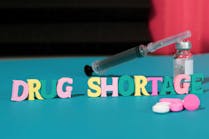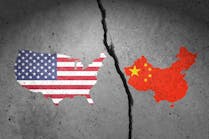Post-pandemic, what’s wrong with the status quo anyway?
Post-pandemic, what’s wrong with the status quo anyway?
Following more than two years of pandemic-driven supply chain disruption and distrust, rife with backordering, hoarding, shortages, stockouts and waste, imagining the healthcare supply chain industry simply throwing up its hands in frustration and doing nothing to prepare for future crises may elicit eyebrow-arching, wide-eyed reactions.
After all, the year 2019 was so … normal and ordinary.
Yet some might argue the effects of the global COVID-19 infection ultimately failed to bring supply chain to its knees, regardless of the bending and buckling of operations so no harm, no foul right?
Healthcare supply chain experts exclaim, “pish-tosh!” and emphasize what they consider the obvious with Healthcare Purchasing News.
“You will never hear me say that we should remain status quo simply because we managed to survive the storm. To stay the course is to ignore the fact that the pandemic has fundamentally changed the way we do business. Perhaps it is our work in the retail or 3PL [third-party logistics] space that is informing my comments here, where the market has demanded a faster reaction, but healthcare logistics is largely an overlay of industry. Permanent changes in those industries are already seeping into the healthcare arena, from next-day delivery expectations, an accelerated demand for home health and the integrated nature of ‘digital front doors.’
“One of the greatest problems with the healthcare supply chain is that we are notorious for finding a workaround instead of enhancing our processes for the future. We are at a critical crossroads where the pandemic has shattered some of the more fragile links in our supply chains, and people must define how they will rebuild them. It is my contention that this rebuild calls for a redesign that pulls in emergency preparedness processes, data-driven strategies, and thoughtful calculus around the supporting technologies that will serve as the third leg of that table.”
Cory Turner, CMRP, Senior Director, Healthcare Strategy, Tecsys
“When I think about the supply chain’s lessons learned during the pandemic, I keep going back to Winston Churchill’s quote, ‘never let a good crisis go to waste.’ COVID-19 was, and in some ways still is, a catalyzing event that forced hospital executives to recognize the importance of the supply chain. This became an opportunity to leverage the supply chain’s newfound influence and recognition to address some of the bigger problems in healthcare. Prior to the pandemic, there was a lot of talk about how providers can deliver higher quality care – and that remains a constant challenge. My hope is the relationships and resiliency that this crisis forged will remain and help healthcare continue to chip away at some of its larger issues such as the rising cost of care and staffing shortages.
“Even as the pandemic begins to morph into an endemic phase, supply chains continue to grapple with problems that will have ripple effects on the system for years to come. Backorders and supply shortages may not be as drastic as they were at the height of the pandemic, but they are still fires that supply chain teams fight daily. I like to think the healthcare industry has learned a lot thanks to the resiliency we’ve built over the last two and half years, but I believe a more dynamic environment is our new normal. Supply chains must be prepared for continual challenges.”
Bonnie Lai, General Manager, GHX Lumere
“There is no scenario where ‘do nothing’ or ’maintain the status quo’ will address the challenges we face in supply chain. With operating margins at or below 0% we cannot rely on hope. We must respond now with new business models and collaborating engagement across all stakeholders in supply chain. We can no longer depend on negotiating better prices. Supply chain must take a strategic position in removing the friction in supply chain caused by inefficiency, errors and waste. Additionally, supply chain needs to streamline the flow of data, goods and services between the source and the consumer. This is the time for supply chain leaders to demonstrate their strategic value to their organizations by bridging the ‘us and them’ gap.
“The past 2 years have shown us that we are all dependent on the success and passion of our healthcare frontline workers.”
Marlin Doner, Vice President, Data Analytics and Product Strategy, Prodigo Solutions
“Doing nothing and/or maintaining the status quo is not an option! As Supply Chain leaders we must continually challenge the status quo! When we become ‘satisfied,’ after that we become complacent. After we become complacent, then we become stagnant. When we become stagnant, we are not useful. Healthcare will always be needed and therefore, healthcare supply chain will always be needed. History enables us to learn from our mistakes. We have had a lot of lessons learned over the past few years. If we do nothing, we have not ‘learned.’ If we do nothing, we are saying that we want a repeat of the past few years. I don’t think so. We can’t change the world or our healthcare supply chain overnight; however, we can take a step forward and make small changes daily to improve and advance the healthcare supply chain.”
Angie A. Haggard, CEO, RDA
“To my observation, memories in the U.S. healthcare industry are shockingly short. In many respects, we’ve already reverted to cost-centric decision making rather than prioritizing supply chain risk and total cost of procurement. Backorders are incredibly expensive and disruptive, yet we watch every day the repetitive ordering of constrained products made in Asia because they may be slightly cheaper. Doing nothing is not an option. The pandemic put the healthcare supply chain in the spotlight, and as an industry and as a country, we need to work together to address changes in the system that we’ve created. This will require transparent communication and collaborative thought combined with policy that will challenge the ‘lowest price mentality’ and incentivize local and domestic manufacturing to improve the integrity of our supply chain.”
Jeff Jochims, Executive Vice President, COO and President, Products Healthcare Service, Owens & Minor
“In general, I expect some health systems to migrate back to their old way of doing business previous to the pandemic – it is only human nature. I do believe many supply chain leaders will embrace the new normal and focus on leveraging their newfound seat at the table as a way to enhance their supply chain to better support the organization. Many health systems are going to challenge their distribution strategy and develop a hybrid model that enables them to have more control and stability.”
Tom Redding, Senior Managing Director, Healthcare, St. Onge
“When it comes to effectively managing a healthcare system’s supply chain, doing nothing or maintaining the status quo is not a viable option – and makes it more challenging to get critical product to the bedside to protect the health of patients.
“During the pandemic, we learned that nearly 64 percent of health systems were still relying on some type of manual or spreadsheet-based inventory management process1. The financial aftermath of the pandemic has pushed us to a new level of change where understanding levels of waste, managing product expirations, increasing charge capture, improving supply documentation and staff efficiency is table stakes – and capturing these insights are made possible through technology. The tech revolution in healthcare is here to stay.”
Shawn McBride, Vice President and General Manager, WaveMark Solutions, Cardinal Health
“Considering the recent challenges, such as pandemic-related supply chain disruptions and labor force shortages to name a few, one must run much faster to remain where they are, let alone make any advancements. In these circumstances, maintaining the status quo is a false presumption for directing business operations and withstanding the headwinds of today and tomorrow.
“In fact, the evolution of technological solutions and innovations is continuing at a rapid pace, and there are many potentially disruptive changes that await. From streamlining the structure of the supply chain, to new robotics, and sensor technologies – those who fail to leverage these technologies will be at a disadvantage. In addition, new regulatory requirements will necessitate new workflows and supporting technologies.
“I have worked with supply chain execution operations across North America and beyond for nearly four decades. While many of the basics remain as fundamental as ever, technology today is not merely enabling small improvements in KPIs [key performance indicators] but rather transforming operations dramatically. For example, mobile robotics can go into an existing warehouse and double the productivity of pickers. RFID can enable constant visibility and error-proofed materials management without additional labor. Temperature-sensing tags can ensure cold chain integrity from source to consumption. These are just some examples of new technologies in the supply chain today. Are you leveraging these technologies to their fullest? They are changing so rapidly that unless you are working with them and learning about them you are falling behind.”
Mark Wheeler, Director, Vertical Marketing Practice Lead, Zebra Technologies
“While the Pandemic looked like a “Black Swan” event, based on leaders such as Bill Gates, these types of events are likely to happen more frequently and hence doing nothing is not an option. The pandemic has shown the gaps in our current supply chain. A lot of these gaps were known and could have been fixed earlier, but we didn’t. The global geopolitical situation is likely to get worse in the next decade. This is going to further destabilize the global supply chains. This will have a direct impact on our healthcare supply chain. How well are we prepared for these disruptions? Those with a short-term plan or no plan are likely to be adversely affected, leading to bankruptcy and closures.”
Ashok Muttin, Founder & CEO, SupplyCopia
“Well before the pandemic, healthcare systems were facing economic headwinds in the form increasing Baby Boomer growth aging into Medicare, which represents a 50% revenue reduction per patient encounter and discharge. And 10 million Baby Boomers are aging in annually between 2018 to 2026. During this same period, on the heels of the Affordable Care Act enacted in 2010, more commercial employer sponsored insured plans have shifted to high deductible health plans, giving rise to higher number of cash pay patients, and as a corollary to consumerism. In parallel, there has been a shift to care delivery ‘outside the hospital four walls,’ where more lower-cost sites of care also translate to increased competition and lower-cost sites of care and reimbursement.
“The pandemic has accelerated trends that were already in play economically and accentuated the need for digitization of many aspects of the operating model, as well as highlighted the underlying issues tied to healthcare inequity and social disparity ramifications. And there’s no turning back or standing still. It’s the Great Reset – new mindset, new priorities and new solutions. If you think you’ve somehow weathered the supply chain storm and you can maintain the status quo, you will likely risk getting challenged or crushed in select key revenue distribution channels.
“Change is inevitable, but I believe transformation has to be made through highly intentional, well-aligned, leadership conscious choice. Organizations who dared to question the status quo and adopted market-impactful solutions to transform their business for sustainability will prove to be leaders coming out of the pandemic.
“Supply chain has been garnering more focused attention at the C-suite level with regards to its strategic importance. If you are a healthcare supply chain leader looking for new or alternative vendors to address shortages in raw materials, medical supplies, contract labor etc., while still creating revenue and operational efficiency for your facility, we advocate for digital technology solutions as a core part of supply chain partners to lock arms with, in an effort to realize the necessary administrative operating efficiencies for long-term sustainability.
“Additionally, of notable importance in an increasingly challenging world of random events, we partner with many healthcare facilities to verify their vendors, maintaining the highest level of compliance, safety and security. We perform sanction checks by using several government databases that list individuals prohibited from doing business in the healthcare industry; reinforcing workforce safety optimization, and essentially pre-screening and credentialing the hundreds of vendors on a healthcare campus before they arrive at the revolving front door. If you are a CMS-funded facility, we offer a COVID-19 vaccine management solution at no cost to ensure that your facility meets the CMS vaccine mandate and to protect your funding.”
Celina Burns, Chief Commercial Officer, IntelliCentrics
“It is critical for supply chains to constantly evolve and consider how to leverage crisis situations, like those of the last few years, as opportunities to accelerate learning and process improvement. We’ve made many investments in people, processes and technology to make us stronger and enable us to be even more effective and resilient in the face of future crises.”
Brandon Reeder, Vice President, Operations, Supply Chain Optimization, Medline
“The status quo is not acceptable. To build and maintain resiliency maturity against supply chain disruptions, we must continue to innovate and invest in people, processes and technologies. Healthcare providers and suppliers also must continue advocating for transparent supply chains from end to end.”
Kyle MacKinnon, Senior Director, Operational Excellence, Premier
“Certainly, there are still strategies and processes that continue to work and will remain. But the status quo is not good enough. Supply chain leaders should be looking at expanding their sourcing reach to diversify their supply base while also reducing costs in typically unmanaged categories like purchased services. They should be investing in advanced analytics to enhance visibility into the supply chain to understand utilization across their system. Finally, leaders should leverage tools to help collect additional performance and risk data about suppliers and their supply chains.”
Keith Lohkamp, Senior Director, Industry Strategy, Workday
“Maintaining the status quo will expose organizations unnecessarily to unpredictable and potentially devasting business and supply chain disruptions. Now is the time to modernize practices to enable ‘radical (supply chain) transparency,’ ‘proactive vigilance’ and ‘agile intervention’ to minimize the risks of disruption we will undoubtedly face going forward, whether they be from prolonged COVID impacts, rising geopolitical tensions, extreme weather events or any other global risk events. “Back in March of 2020, a colleague and I wrote and published a blog called, ‘Beyond COVID-19 Risk Management: The Need to be Solid as a ROC (Risk Operations Center.’ Here’s a quote from that blog: ‘We believe that COVID-19 is a watershed moment for business. A turning point from which managing business disruption risk should never be the same. Many companies will recognize this in hindsight, but we urge you NOT to treat this outbreak as an anomaly. In our current interconnected business ecosystem, it is unlikely to be the last disease outbreak with global business ramifications. On top of that, add the increasing likelihood of other catastrophic natural disasters like extreme weather events or geo-political events with global impact and thus the need for a new risk management model is evident.’2
“Fast forward, two and a half years, and the current global risk environment has proven our case. Today, medical supply chains continue to experience significant disruptions as medical providers throughout the United States experience critical shortages of vital supplies and devices3. In late July, the United States Food and Drug Administration (FDA) published ’30 different medical devices and supplies on its shortage list4. These shortages are the result of increased COVID demand, component shortages, shipping delays, manufacturing compliance issues, etc.
“Beyond China’s continued zero-COVID policy lockdowns, we now face supply chain challenges due to the war in Ukraine and possibly as a result of escalating tensions between China and Taiwan. Organizations should be prepared for further disruptions as a result of shipping and logistic problems, semiconductor shortages (impacting medical device manufacturing) and components/ingredients shortages (impacting medical supplies availability).”
Atul Vashistha, CEO and Founder, Supply Wisdom
“Not an option. The last two years have shown us that our industry needs significant change around transparency, demand planning and data that allow us to better manage supply disruptions. We all should look at the supply chain integrity on a global scale as a result of the pandemic and the challenges that remain due to inflation.”
Margaret Steele, Senior Vice President, Med/Surg, Vizient
References:
1. Bailey, B. (2020, March 3). Six Ways Health Systems Can Save Millions in 2020. Retrieved from SupplyChainBrain: https://www.supplychainbrain.com/blogs/1-think-tank/post/30934-six-ways-health- systems-can-save-millions-in-2020
2. https://www.supplywisdom.com/resources/roc-risk-operations-center-risk-management/
3. https://www.aamc.org/news-insights/shortages-syringes-dye-diagnostic-exams-how-world-events-are-straining-everyday-health-care-supply
4. https://www.fda.gov/medical-devices/coronavirus-covid-19-and-medical-devices/medical-device-shortages-during-covid-19-public-health-emergency#shortage

Rick Dana Barlow | Senior Editor
Rick Dana Barlow is Senior Editor for Healthcare Purchasing News, an Endeavor Business Media publication. He can be reached at [email protected].





